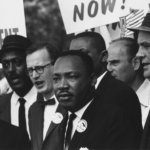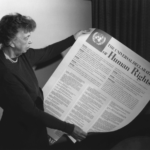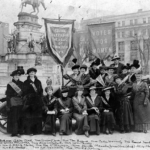In this lesson, students will learn about the individual rights that are included in the Bill of Rights and current issues relating to them. Students will use C-SPAN Classroom’s Constitution Clips to explore what each of these rights mean and determine how these rights apply to current events in America. This lesson works well with classes with one-to-one devices or in flipped classrooms.
Competing Voices of the Civil Rights Movement
When most people think of the Civil Rights Movement in America, they think of Martin Luther King, Jr. delivering his “I Have a Dream” speech on the steps of the Lincoln Memorial in 1963 and receiving the Nobel Peace Prize the following year. But “the Movement” achieved its greatest results — the 1964 Civil Rights Act and the 1965 Voting Rights Act — due to the competing strategies and agendas of diverse individuals. Even black Americans, the primary beneficiaries of this landmark legislation, did not agree on the tactics that should be used to secure the equal protection of their rights. This unit presents the views of several important black leaders who shaped the debate over how to achieve freedom and equality in a nation that had long denied a portion of the American citizenry the full protection of their rights.
Rights in America
This DocsTeach page includes a variety of primary sources and teaching activities exploring the ways Americans, including African Americans and others, have fought for, attained, and protected their rights. Many documents at the National Archives illustrate how individuals and groups asserted their rights as Americans. Use this site to find teaching activities to explore the topics such as slavery, racism, citizenship, women’s independence, immigration, and more.
March on Washington: Lesson Plans & Resources

On August 28, 1963, approximately 250,000 people participated in the March on Washington for Jobs and Freedom, which is considered to be one of the largest peaceful political rallies for human rights in history. Among other events, the march participants gathered at the Lincoln Memorial to hear Martin Luther King Jr. deliver his iconic “I Have a Dream” speech. Many consider The Great March on Washington to be the event that encouraged the passage of the Civil Rights Act of 1964 and the Voting Rights Act of 1965. The Share My Lesson team has created this collection of free lessons and classroom materials to help middle and high school educators teach their students about this historic event.
Teach Human Rights: Lesson Plans & Resources

The historical struggle for human rights is something that affects us, our children, and future generations as we fight for equity and inclusion in an increasingly torn society. It can also be difficult to speak with students about sensitive subjects, which is why this Share My Lesson collection provides expertly curated lesson plans, resources, and activities that define these rights, develop a global awareness, and teach how we can all make a difference when we act together.
Freedom Summer 1964
Freedom Summer is a digital learning tool (available on the web or as an app) for teachers and students that explores key events surrounding this time in America’s history and the impact of the civil rights movement on civil rights legislation. Players predict the outcomes of civil and congressional actions and discover how the events are intertwined. Students have the opportunity to view informative intro and outro videos and analyze 20 primary sources depicting images of civil rights events. Analysis of a variety of primary sources and supplemental information leads students to identify varying perspectives and potential outcomes. Freedom Summer is formatted for all types of computers and mobile devices, including Chromebooks, and can be found on the website or in any app store for download.
Amendment Worth A Thousand Words
With many pictures posted all over every social media platform, the #amendmentworthathousandwords’ overall mission will be to enlighten many of the rights promised to people by the Constitution. Through this challenge, many will become aware of their rights and what the Constitution does not only for them, but for all Americans as well! Lesson plan by Eboni Jenerette
Women’s Suffrage and Equal Rights: Lesson Plans and Resources

On August 18, 1920, the 19th Amendment to the United State Constitution was ratified, thus granting women the right to vote. The ratification of this amendment was a result of the powerful, unwavering momentum of hundreds of women who first convened a women’s rights convention in Seneca Falls, New York. This collection provides free lessons that will help students learn more about this important time in history, highlighting important developments in not only Women’s Rights, but U.S. Civil Rights and other amendments to the Constitution.
Bill of Rights Booklet – Elementary and Middle Schools
Want your students to have their own Bill of Rights booklet? This booklet has the verbiage from the Bill of Rights and a space for students to be able to paraphrase what each amendment means.
Do I Have a Right?: Bill of Rights Edition (Game and Teacher Guide)
In the Bill of Rights edition of Do I Have a Right? your students run a law firm that specializes in constitutional law, specifically the rights protected in the Bill of Rights. Clients bring various complaints, and students must identify if they “have a right.” As students successfully resolve cases by matching them with the correct attorneys, their law firm grows along with the skills of their lawyers.